Is it poisonous and why is it dangerous?
All types of milkweed have one specific property in common - the poisonous milky sap, which is released when the plant is damaged.
It protects the flower from herbivores and is contained in all its parts:
- fundamentally;
- in the stem;
- in the leaves.
The toxicity of the juice differs between different types of milkweed. If you decide to use it as a folk remedy, you need to remember that when the norm is exceeded, the spurge turns into poison, and not into medicine.
Any internal use of milkweed requires special care and precise dosage.
External use is also dangerous. Contact with the skin can cause ulcers and long-lasting burns, and accidental contact with the eyes can cause complete or partial loss of vision. Milkweed juice is especially dangerous for allergy sufferers.
Signs of intoxication appear after 8-12 hours after the ingestion of harmful substances. There have been known cases of severe human poisoning during treatment with milkweed.
In cows, the consumption of milkweed stains milk pink, hence the popular names for the flower: wolf, snake and even devil's milk.
How to protect yourself?
- To protect yourself when transplanting or reproducing a flower, in order to avoid getting the juice on the skin, you need to use protective equipment, such as gloves (you will learn about the reproduction and cultivation of milkweed here).
- Do not change the course and dose yourself when treating with drugs containing milkweed poisonous substances (only after consulting a qualified doctor).
- Do not make your own medicines that contain milky juice.
What to do in case of poisoning?
In case of poisoning, the victim is observed:
- vomit;
- nausea;
- colitis;
- low blood pressure;
- loose stools;
- pain in the abdomen.
In more severe cases, the following are observed:
- fainting;
- convulsions;
- breathing disorders;
- heart failure.
At the first sign, you urgently need to rinse the stomach with a suspension of activated carbon in a 2% sodium bicarbonate solution and call an ambulance.
For treatment are prescribed:
- saline laxatives - magnesium or sodium sulfate (up to 25 g);
- cleansing enemas;
- drinking plenty of fluids.
Also, a person needs to provide complete peace - not only physical, but also emotional.
In case of contact with eyes, rinse immediately with plenty of water.
Primitive people used the poisonous sap of milkweed on arrowheads and to euthanize fish.
More information about the chemical composition, benefits and dangers of milkweed can be found in this material.
Latest articles
5 recipes for delicious and juicy cutlets that you want to eat right away without leaving the stove today, 4:20 pm
How to shape a seedling of any tree with toilet paper today, 2:31 pm
Why many Soviet tanks during World War II did not have a muzzle brake today, 13:15
Ampulothrower: why the rival flamethrower could not push him off the battlefield today, 11:37
Why do resellers purchase large quantities of silicone grease today, 10:20
7 reasons why you should sleep on a buckwheat husk pillow today, 09:10
An elite penthouse on board an airliner eclipsed the plane of the President of the United States with its luxury 07/23/2020, 10:23 PM
5 Practical Feng Shui Furniture Arrangement Tips That Will Attract Love to Your Home 07/23/2020, 9:36 PM
Is it worth pouring mining into the thresholds in case of rust, or will it only get worse 07/23/2020, 19:40
Novelty in interior design: "living" furniture that attracts attention 07/23/2020, 18:01
All articles
Care features
An indoor plant does not require any specific conditions to grow.But still, in order for the flower to be comfortable, it needs to be provided with appropriate care.
Watering. Euphorbia does not like overflow, from this it can die. In hot weather, watering is increased, but waterlogging of the soil is not allowed. In autumn, as well as in spring, soil moisture should be minimal. Some types of indoor milkweed do not need watering in winter, and other plants wither if the earthen lump in the pot dries up.
Humidity. Undemanding spurge grows well in conditions of low or high humidity. Of course, it is best to create average air humidity parameters for him, but if this cannot be done, then nothing terrible will happen to the flower.
Important! If the plant is in conditions of low humidity and low air temperature, then there is a risk of rotting of the root system or wilting and subsequent fall of foliage.
Air temperature. Euphorbia is more related to thermophilic flowers.
It will develop comfortably at air temperatures from +18 to +25 degrees. In summer, the plant can be placed on the balcony, but it cannot be left outside if the air temperature drops to +12 degrees.
Lighting. Depending on the variety, the flower must be provided with either regular exposure to sunlight, or partial shade, or the supply of diffused light.
Location. Most often, spurge is placed on windowsills. Large flowers are placed on the floor. It is important that the plant is protected from drafts. He does not like euphorbia and "neighborhood" next to heating devices.
Priming. It is advisable to purchase a special soil mixture for indoor milkweed with the inscription "For succulents" or "For cacti". A drainage layer must be present in the pot.
Fertilizers. During the period of vegetative growth, fertilizing is applied to the soil every 2 weeks. An ideal option is specialized fertilizers for cacti or succulents. Flowering forms of milkweed require fertilizing that includes potassium. In autumn and winter, top dressing stops.
Pots. A clay or plastic pot is an excellent option for growing milkweed. The plant will feel comfortable in a shallow, but voluminous pot.
Specificity of poisonous domestic plants
The poisonous inhabitants of our windowsills often bloom effectively and have a pleasant aroma. Strong-smelling specimens can harm allergy sufferers. Even in a completely healthy person, due to too active exposure to essential oils of flowers, there may be a deterioration in well-being with headaches and clouding of consciousness. The degree of allergic manifestations depends on the characteristics of a particular organism and the age of a person.
 List of poisonous indoor flowers
List of poisonous indoor flowers
In poisonous plants, their juice is especially dangerous, the ingress of toxins of which into the esophagus causes poisoning with various side effects. In particular, rash, skin reactions in the form of burns, ulceration, dyspeptic manifestations, dizziness may occur. In some cases, it is necessary to seek specialized medical attention.
Many species of Euphorbia, for example, have thorns that attack the skin.
Please note: Poisonous plants are strictly forbidden to be placed in bedrooms and in children's rooms due to toxic fumes. In other areas, they should be inaccessible to children.
Under what conditions can milkweed be poisoned?
Indoor spurge poisonous causes intoxication with involuntary or deliberate use of it inside. A negative reaction of the skin is manifested by burns, sometimes quite extensive. This happens because the flower juice is released in the air very quickly and in large quantities.
Ways of negative impact:
Transplanting, cutting an indoor flower without observing the rules of caution;
Work in the garden without the use of protective equipment;
Preparation and treatment with medicinal substances based on room milkweed according to unverified folk recipes;
Overdose of infusions and decoctions;
Accidental ingestion of the inside of the leaves and inner fluid of the flower.
Poisoning and burns in children are a frequent reaction of the body when plucking and playing with wild species of milkweed. The rate of development of intoxication depends on the physical condition of the body, the presence of chronic diseases and the amount of poisonous substance consumed in food.
Families of poisonous indoor plants
Many poisonous house flowers release toxic substances that, when in contact with the skin, mucous membranes and the respiratory system, can provoke severe allergic reactions, shortness of breath, dermatitis, burns, itching and redness.
Of course, an experienced florist knows which flowers can be near people and which are dangerous. Several families can be distinguished among the most poisonous and dangerous plants. Curiously enough, many of them decorate the house of almost every second inhabitant:
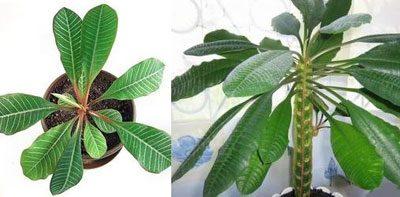
- Kutrov family. Representatives of this family are the most poisonous houseplants, among them adenium, pachypodium, dipladenia, allamanda, cariss. Despite the fact that these specimens are cultivated as ornamental plants, they can only be worked with rubber gloves. The fact is that some members of this family secrete milky juice, which is often poisonous. These poisonous plants are best grown exclusively in greenhouses. Firstly, because by growing them at home, children and animals can get to them, and secondly, representatives of this family are from the tropics and love warmth and dampness.
- Aroid family. It includes such specimens as spathiphyllum, aglaonema, alocasia, dieffenbachia, etc. All of them are toxic due to the formation of oxalic acid, enzymes and proteins in them. How dangerous contact with them is, it becomes clear at least from the fact that the caustic components listed above are components of various detergents and cleaning agents. Due to the presence of such components, the juice of aroids is able to corrode the skin, so you should not take on the damaged plant without gloves.
- The euphorbia family. In the milky juice of representatives of this family, the toxic substance euphorin is present. On contact with the skin, this substance causes burns and inflammation, therefore, when caring for plants such as euphorbia, akalifa and croton, be sure to protect your hands.
- The nightshade family. Everyone is familiar with such vegetable fruits as potatoes and tomatoes - they also belong to the nightshade. In addition to them, paprika, brovallia and brunfelsia are often grown at home. The fruits of these poisonous plants are capable of affecting the general condition of a person through the gastrointestinal tract. If you eat a few berries, nausea first appears, after vomiting and diarrhea and, as a result, a lethargic and apathetic state. Therefore, having these plants in your home, you need to make sure that the pet or child does not eat the poisonous fruits.
Can I keep it at home or not, and why is it sometimes impossible?
Spurge can be kept at home, but away from small children and pets.
Sad but true: Most houseplants are toxic to cats. There is even such a thing as "chronic poisoning".
Your pet may feel great for many years and not show any signs of illness, but at some point, his health deteriorates sharply, and the animal begins to fade away before our eyes. Such a cumulative effect.
The best types for home keeping and caring for them
Since the variety of species is quite wide, consider the most popular ones for home content:
- Euphorbia polychroma;
- Euphorbia pulcherrima;
- Euphorbia myrsinites.
Milkweed care rules:
- These types of milkweed are best kept at room temperature (15 ° C to 25 ° C); in winter, the room temperature should not drop below 12 ° C.
- Since the plant is light-requiring, it should be kept on a windowsill, avoiding direct sunlight, as they can cause burns.
- The plant, like any succulent, requires moderate watering.
- Dry air will be preferable to humid air, although humidity is not particularly important for milkweed.
- Be sure to put drainage on the bottom of the pot, otherwise the roots may rot.
Indoor flower lovers always try to surround themselves with pleasant and interesting plants. Previously, geraniums and violets were very popular on window sills. Today, you can increasingly find euphorbia, of all types and forms.
With proper care and taking precautions, it will bring you only positive emotions.
Plants Whose Poison Cause Serious Disease
A separate group of dangerous plants includes specimens containing dangerous toxins, which in high doses can lead to illness and serious complications.
Japanese aucuba, fatsia and polisias, shefflera and fatshedera, which are part of the araliaceae family, can cause allergies and indigestion. Ivy, which is part of the same family, is no less poisonous. All parts of it are poisonous. Favorite by many contain oxalic acid salts. They can cause oral irritation, burns, vomiting, and difficulty swallowing. Most of all they contain toxins in tubers. There is a dangerous poison in the bulbs of the plant - glorioses. It can cause severe kidney disease and impair blood clotting. When poisoned with toxins of this plant, diarrhea, nausea and vomiting appear. Contains toxic substances and unripe lanthanum berries that cause poisoning, diarrhea, vomiting, weakness and serious liver problems.
Succulents known to many, such as akalifa, poinsettia or the most beautiful euphorbia, croton, jatropha, which are part of the euphorbia family, contain euphorbin in their milky juice. It can cause burns to mucous membranes and skin. Therefore, when caring for a plant, you need to ensure that the juice does not get into the eyes, as this can lead not only to irritation of the cornea of the eye, but also to blindness. If the juice of the plant enters the mouth, it can cause severe burns to the mouth and throat, indigestion and disturbances in the functioning of the nervous system.
In flower shops today you can see a very beautiful decorative pepper with fruits, but like other plants of the nightshade family: brovallia, nightshade or Jerusalem cherry, brunfelsia, it is poisonous. And its fruits are highly toxic. For example, in the juice of brunfelsia - the poisonous substance brunfelzamidine, if it enters the stomach, will cause not only upset, but also coughing, trembling, lethargy and even seizures.
Skin inflammation and severe dermatitis and eczema are what you can get if ficus juice gets on your skin.
Aralievs
This large family of tropical plants, including more than 70 genera and about 840 species, is known for its stellar representatives - ginseng, eleutherococcus and aralia, which are used in medicine as excellent immunomodulators.
This family conquered flower growers with a variety of forms - from lianas to shrubs, as well as the beauty of the deciduous cover. All kinds of ivy, fatsia and sheffler are attractive precisely for their textured, split, shiny leaves.
All parts of plants of the Araliaceae family secrete sap when broken, which is very poisonous. Some species form berries that cause severe poisoning when eaten. Therefore, these species are kept away from children and pets.
Advice. If the child nevertheless ate the berry of the araliaceae, it is necessary to urgently induce vomiting and give several tablets of activated charcoal. And in case of severe poisoning - do not hesitate to consult a doctor.
Poisonous home flowers
Not every housewife knows which house flowers are poisonous, and such information will be useful for owners of a large number of plants. Of course, many of them are very useful, as they filter the air and are pleasing to the eye. But there are those that are capable of harming a person or an animal.
Poisonous house flowers:
The well-known ficus plant has an adverse effect on people. Its juice can irritate the skin and even provoke an asthma attack.

Dieffenbachia, which is popular in offices, can cause dermatitis. If its juice gets into the eyes, irritation and even conjunctivitis will appear. If its juice gets into the cat's mouth, the animal may die.

Monstera leaves contain toxins that cause a burning sensation in the mucous membranes and provoke digestive upset.
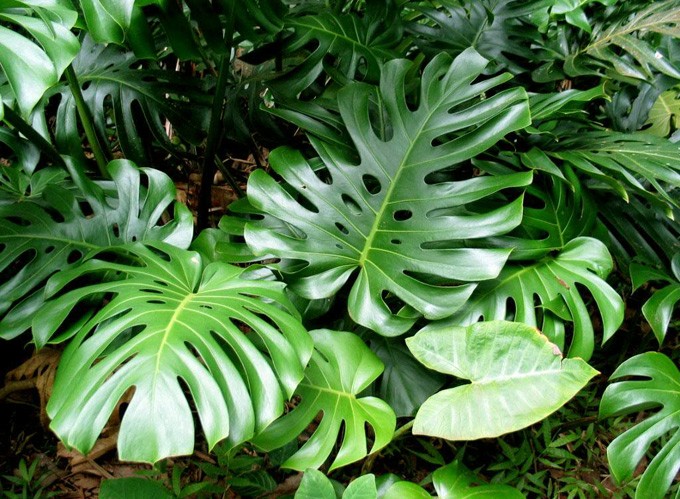
Oleander should be looked after with gloves, as it is poisonous.

Spathiphyllum, although beautiful, but its juice, when it comes into contact with the skin, causes an abscess.

The pachypodium lamera is dangerous for animals and children due to its leaves.

Poinsettia is very beautiful, but its milky juice provokes skin irritation and causes blindness if it gets into the eyes.

Adenium can penetrate the skin directly into the bloodstream and cause intoxication.

Azalea is quite popular, but it is included in poisonous house flowers. If the leaf is swallowed, it will cause severe vomiting and profuse salivation.

Milkweed juice provokes skin redness and burning. It can cause blisters. If swallowed, nausea, vomiting and diarrhea will appear. Even dizziness and seizures are possible.

Gloriosa luxurious is dangerous if a large amount of poison enters the human body. Because of it, not only can nausea and vomiting appear, but hair loss and even kidney damage are possible.
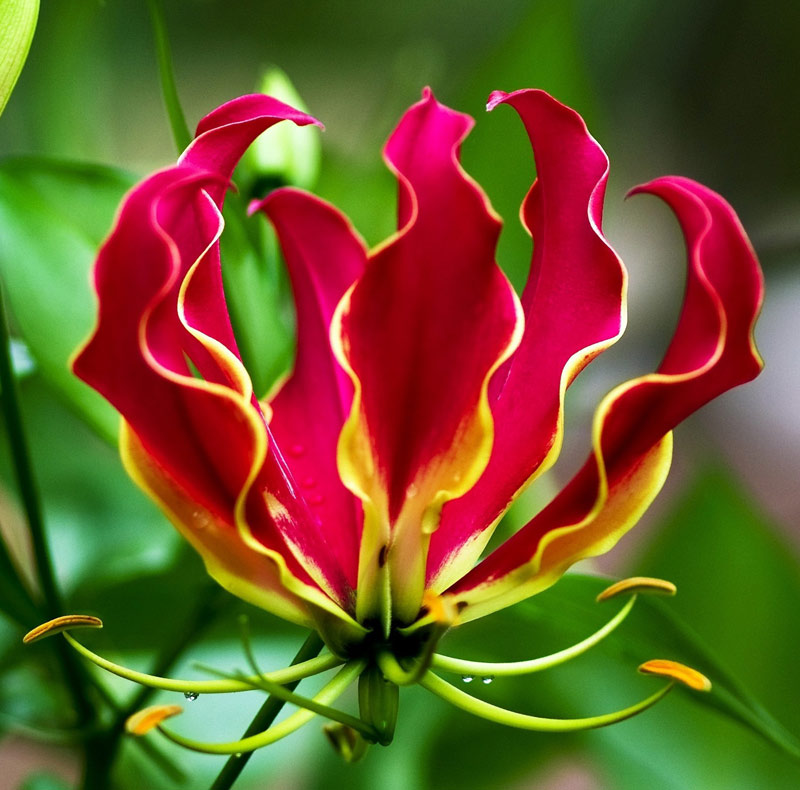
If you swallow hydrangea juice, sweating will increase and stomach pain will appear.

Brovalia is beautiful, it causes intoxication.

Ivy, eaten by a pet, can lead to death of the pet.
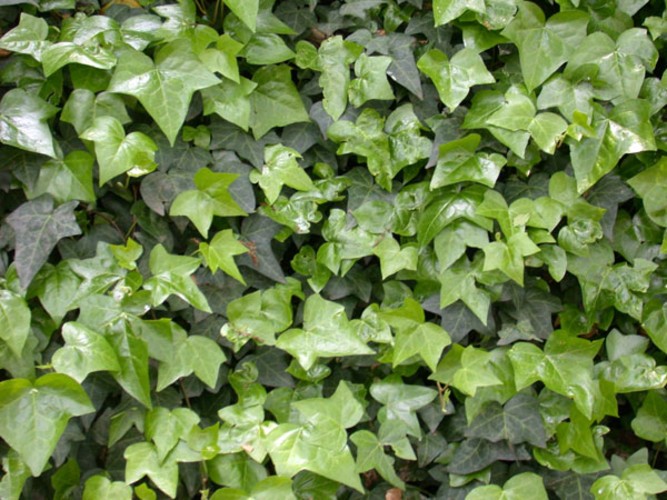
The poison of clivia provokes vomiting, in severe cases, paralysis.
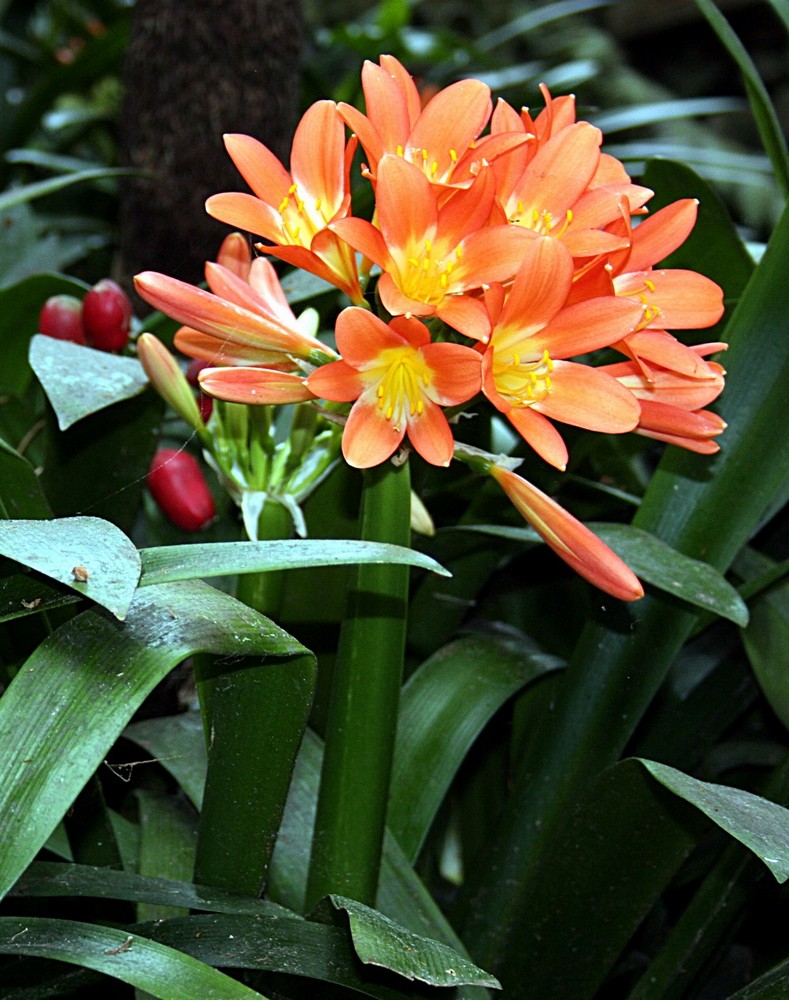
Nightshade fruits are deadly as they cause severe poisoning.

Cyclamen irritates the skin.

Capsicum is also dangerous to animals.

Aloe is good for humans, but it can kill animals if they eat it. A person may become poisoned by an overdose of juice.

Especially poisonous plants for animals and children
Unfortunately, some indoor plants contain toxic substances. People who take care of them in the usual way may not even be aware of this - after all, they are completely safe until you try to put them in your mouth. But try to explain to your cat or guinea pig that the plant in this pot is inedible!
For both pets and small children, any plants from the family of amaryllis, aroid, kutra, nightshade, euphorbia are dangerous. Budgerigars, for example, just need to peck at such plants a little, as their digestion is disturbed and their blood pressure rises.
Plants, the secreted substances of which irritate the skin and mucous membranes, are also undesirable. These are ivy, shefflera, primrose, cyclamen.
But not only potted flowers, but also cut flowers can be poisonous! Even in a vase, it is undesirable to put bouquets of tulips, hyacinths, daffodils, carnations, lilies, gypsophila, milkweed or hellebore if there are animals or small children in the house.
Amaryllidaceae
Amaryllidaceae are not as dangerous to their environment as other plants - toxic substances are concentrated in their bulbs or tubers. However, it is better to remove such plants as hippeastrum, clivia and hemantus away from domestic "rodents".
Aroid
Representatives of the aroid family are often found in our homes. These include Dieffenbachia, Aglaonema, Alocasia, Anthurium, Caladium, Epipremnum, Syngonium, Monstera, Philodendron, Spathiphyllum, Zantedeschia, Zamiokulkas.All of these plants contain substances that irritate the skin and mucous membranes.
Kutrovye
The milky sap of plants from the kutrov family is dangerous for both humans and pets. Therefore, keep plants such as mandevilla, adenium, allamanda, catharanthus, pachypodium away from small children and animals.
Euphorbiaceae
Milky juice of euphorbia irritates the skin and mucous membranes. Place them out of the reach of children and pets, and be sure to wear gloves when handling them. Euphorbiaceae include such popular indoor plants as croton, jatropha, akalifa, euphorbia, poinsettia.
Nightshade
The shiny and vibrant fruits of the ornamental pepper attract the attention of both dogs and cats. Just wanting to play with plants, they will not hesitate to try them by the tooth.
However, all parts of plants from the nightshade family contain poisonous substances. This applies not only to ornamental peppers, but also to annual brovallia, the tirelessly blooming brunfelsia and other decorative species of nightshade.
NAME OF POISONOUS ROOM PLANTS AND PHOTOS
CYCLAMEN (PERSIAN)
It is believed that cyclamen in the home helps to ward off bad dreams and fears, and it should be placed in the bedroom at the head of the bed. We will not argue about the magical power of Cyclamen, but it is necessary to warn about its poisonous properties. Sometimes it is recommended to bury the juice of the cyclamen root from sinusitis, and this should not be done in any case. Not only can you burn the mucous membrane, you run the risk of getting fever, sore throat and shortness of breath. The most poisonous parts are the seeds and roots of the plant, the fresh sap of which can irritate or inflame the skin.
AMARILIS BELADONNA
Plant bulbs that contain the alkaloid lycorin are poisonous. In small doses, lycorin has an expectorant effect, and in large doses it induces vomiting. If suddenly a leaf of a plant breaks off and milky juice comes out, it is better to wash your hands thoroughly and not touch your eyes.
DIFFENBACHIA
The plant is able to improve the chemical composition of the air in the room, but we do not recommend rushing to put it in the bedroom or nursery. The sap of the plant is poisonous, especially the one contained in the stem. It can cause serious digestive and respiratory problems and cause burns if it comes into contact with the skin of the face or hands.
If you have a plant in your home, it is best to care for it with gloves. By the way, it is generally forbidden to grow dieffenbachia in kindergartens.
GERANIUM
Yes, we have not confused anything. This plant is, of course, very useful. On the one hand, geranium is an excellent antiseptic, helps relieve stress and tension, relieves pain in otitis media and tonsillitis. However, there are people whose smell of geranium can provoke a severe asthma attack and cause an allergic reaction. Geranium (as one of the poisonous indoor flowers) is also contraindicated for pregnant women, people with low blood sugar, young children, and those taking birth control.
SPURGE
Species of euphorbia and europhobia, similar to cacti, are indeed poisonous.
Milkweed juice can cause burns, and if ingested, nausea, diarrhea, dizziness and mucosal burns. Strange, but it is these plants that are very often seen on the windowsill in school classrooms.
ALOE STRIPED
The most valuable and beloved aloe has two poisonous brothers - striped aloe and terrifying aloe. All parts of these plants are dangerous, and mainly because most types of aloe are considered medicinal, and they are very often used as a home remedy for treatment. So, striped and frightening cannot be used for medicinal purposes! They can cause stomach and uterine bleeding and, in pregnant women, cause miscarriage.
HYDRANGEA
All parts of this plant contain poison.Touching a hydrangea is completely safe, but if hydrangea juice accidentally gets into the body, it will cause increased sweating, worsen blood circulation, stomach pain, itching, nausea and muscle weakness.
AGLAONEMA CHANGEABLE
The juice and berries of the plant are poisonous. The juice can cause swelling and soreness in the mouth and throat, and conjunctivitis on contact with the eyes.
- If you have small children or pets (especially cats), it is best not to buy poisonous houseplants at all.
- Very often milky juice is poisonous. If you see that when the stem is broken, the plant secretes white juice, it is better not to touch it, and even more so do not scratch your face and do not rub your eyes with your hands.
If the plants are already growing in your home, and you did not know that they are poisonous, move them higher away from children, and in the case of a cat, try covering the base of the pot with cling film so that the animal does not dig up the soil. By the way, sometimes cats chew on the leaves to quench their thirst, so give her plenty of water in a bowl so that she does not touch the poisonous indoor flowers.
Bright and attractive, but deadly
poisonous indoor plants
, the varieties of which in their natural habitat thus protect themselves from insects and animals, do not lose their properties when grown in a pot. And even when transplanting or reproducing them, you need to follow safety rules and always wash your hands immediately if their juice gets on your skin or eyes.
Should you throw the flower away if you find it to be poisonous, or just take precautions when caring for it?
Flowers that cause skin irritation
Most poisonous plants can irritate the skin. Some crops only cause redness, while others can cause burns or even blisters.
Anthurium
The compact home culture, also known as “male happiness,” has become popular for its vibrant calla-like blooms and omens. However, there is one more feature - the leaves of anthurium contain oxalic acid, which has an irritating effect. If it comes into contact with the skin or mucous membranes, it causes swelling, burns, and if a person is prone to allergies, ulcers or dropsy.
 Anthurium leaves contain oxalic acid
Anthurium leaves contain oxalic acid
Dieffenbachia
An ornamental houseplant has large silvery green leaves and can grow over one meter in height. Toxins in the aerial part of the flower are often the cause of inflammatory dermatitis. The mucous membranes react to them with swelling, redness, burns. Once inside the body, substances can provoke an upset stomach or respiratory arrest.
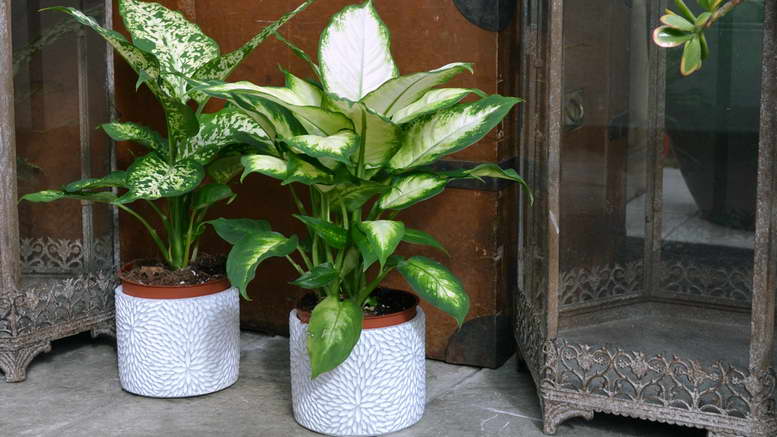 Ornamental houseplant dieffenbachia
Ornamental houseplant dieffenbachia
Cactus
Spiny perennials are known for their variety and unpretentiousness. The sharp needles covering the succulent's thick trunk can be quite dangerous to humans. In addition to painful sensations upon contact with them, long non-healing abscesses are often formed at the puncture sites.
Plumeria
An exotic tropical tree with incredible beauty and strong floral aromas. During flowering, it can emit a jasmine, lily of the valley, citrus or spicy scent. The entire aerial part of the plant contains milky sap, which, when it gets on the skin, causes irritation, rash, itching. People who are prone to allergies can get inflammatory dermatitis.
Poinsettia
An incredibly beautiful plant with bright scarlet flowers against a background of dark emerald green is very dangerous for allergy sufferers. The Christmas star, as this representative of the Euphorbia family is also called, is rich in rubber. In places where the skin has come into contact with milky juice, it turns red, becomes covered with a rash, and sometimes blisters. Accidentally hitting the mucous membrane of the eyes, the poisonous substance often leads to burns of the cornea.
Spathiphyllum
Women's happiness, like anthurium, is a fairly popular plant among flower growers.It grows into a compact herbaceous bush, and during flowering is covered with snow-white inflorescences-sails. The juice released when a leaf or peduncle is damaged can provoke poorly healing sores. If ingested, it causes diarrhea, vomiting, stomach pains, and can lead to respiratory arrest.
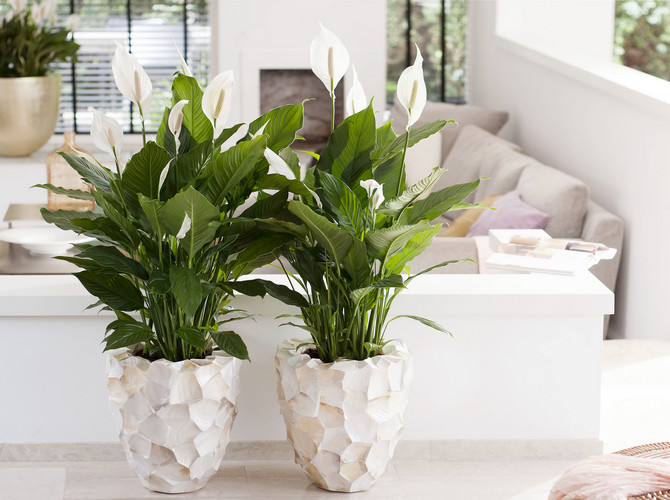 Spathiphyllum is a popular plant among flower growers
Spathiphyllum is a popular plant among flower growers
Cyclamen persian
A miniature home flower with velvety leaves and delicate buds is often used in the treatment of sinusitis. However, it is not recommended to bury pure juice in the nasal passages - the substances that are rich in all parts of the perennial, with a strong concentration, cause burns of the mucous membranes. As a result, the body temperature rises, breathing failures are observed, and the throat begins to hurt.
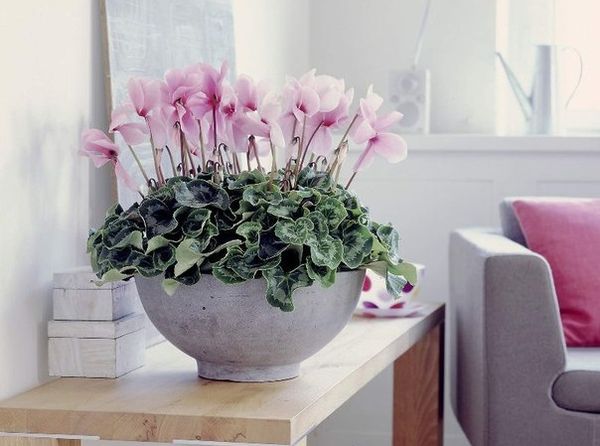 Cyclamen persian - miniature home flower
Cyclamen persian - miniature home flower
Exotic representatives of the flora were endowed with poisonous sap from nature for good reason - in the natural environment it acts as a good protection from animals and pests. Some growers are afraid to start such plants at home, but it is enough to follow simple safety measures so as not to put yourself at risk.
Is spurge dangerous?
Growing spurge at home is not as safe as it seems. The thing is that the milky sap of the plant (it is secreted by all varieties of milkweed) is poisonous.
To find out whether euphorbia is poisonous or not, it is enough to determine what consequences a person may have after improper handling of the plant.

Skin burn
When transplanting an indoor flower, it is important to wear rubber gloves. If the milky juice of milkweed gets on the skin unprotected by special means, it will provoke the formation of inflammation, irritation or burns.
In people prone to allergies, living in the same room with milkweed can cause an allergic attack - sneezing, runny nose, nasal congestion, coughing. Upon contact with the flower, the skin will instantly become covered with a small rash or swelling.
If the juice accidentally gets on the skin, immediately rinse the damaged area with running water. Then apply ice to the inflamed skin and be sure to take an antihistamine (Suprastin).
Burns of the mucous membrane of the eye
Serious harm to human health is caused by the ingestion of the milky sap of the plant in the eyes. The consequences of this are unpredictable - either irritation of the mucous membrane, or temporary impairment of visual function, or complete blindness.
Poisoning
Even a slight ingress of milky juice into the mouth can provoke burning, itching and inflammation of the mucous membrane. If the juice is accidentally swallowed, then the consequences can be much more serious, namely, respiratory failure, dizziness, swelling of the tongue, a decrease in body temperature regimes, convulsions, fainting.
If the juice gets into the mouth or respiratory tract, it is impossible to hesitate to see a doctor. The specialist will determine which therapeutic procedures will help prevent poisoning. Before the arrival of the doctor, it is recommended to take activated charcoal, drink plenty of water and provoke vomiting, take an antihistamine, drink a laxative, or do an enema.
Dieffenbachia.
Dieffenbachia is another plant that is familiar to us, which, unfortunately, contains alkaloids that can cause burns and cause swelling and allergic reactions if any part of the plant is damaged. As a rule, irritation does not appear on the skin immediately, but after some time.
It is interesting! In slave-owning Brazil, dieffenbachia was used to punish guilty slaves. They were forced to eat a dieffenbachia leaf, after which the slaves developed swelling of the tongue and larynx. In this state, they could not talk, which is why this method of punishment in Brazil was called dumb rods.


